Macadamia integrifolia and Macadamia tetraphylla
The smooth-shelled Queensland nut, M. integrifolia, and the rough-shelled nut, M. tetraphylla, are two types of macadamia native to Australia.
They are members of the large Proteaceae family that includes protea flowers.
This majestic tree provides ample shade, spring blossoms, and nuts that contain deliciously smooth, sweet kernels that fetch a king’s ransom in the grocery store.
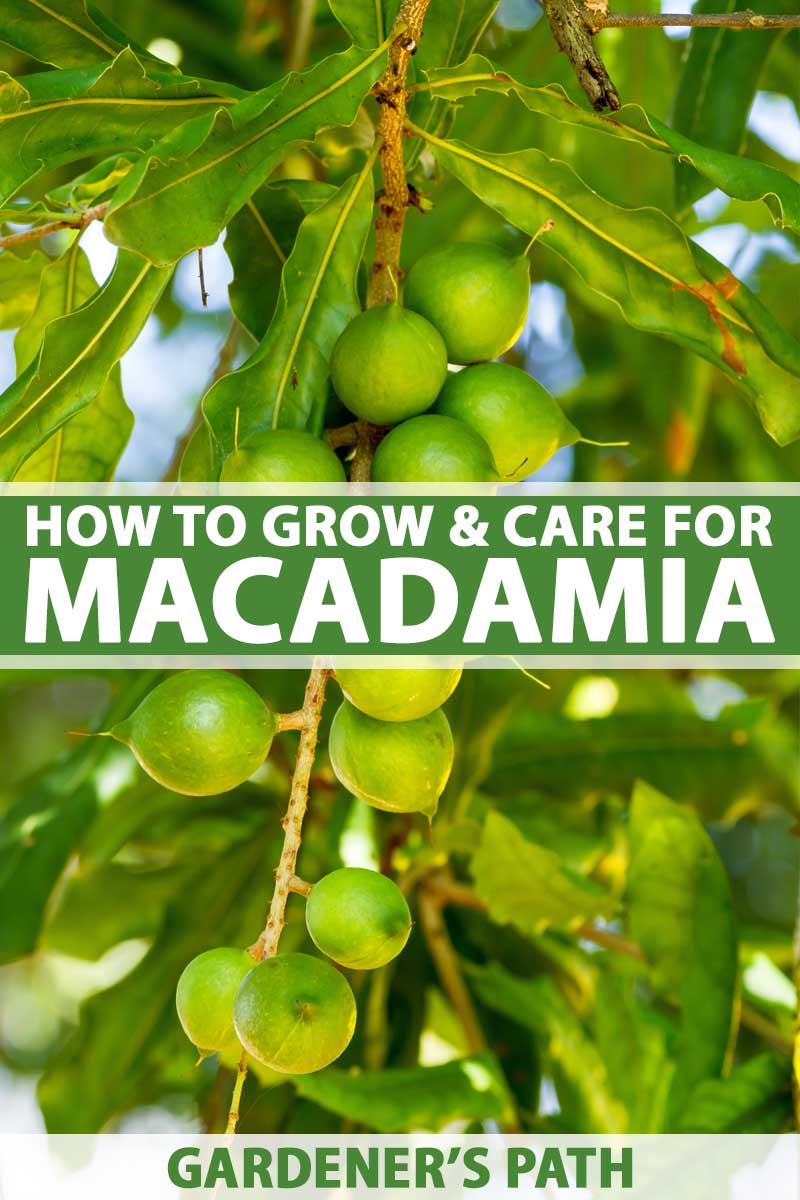
We link to vendors to help you find relevant products. If you buy from one of our links, we may earn a commission.
In this article you will learn how to cultivate and care for macadamia in USDA Hardiness Zones 9 to 11.
What You’ll Learn
Meet the Macadamia
The macadamia is a glossy broadleaf evergreen with leaves that resemble holly, flowers ranging from pink to white, and edible nuts that ripen at random times during the growing season. Two species are grown for consumption.
Culture
This is a self-pollinating tree that does not produce “true” from seed. While you may start with seed, it could take more than 10 years for your tree to mature, and it may or may not set fruit.
Alternatively, most folks start with grafted plants to jumpstart the process and cut the maturity time in half.
While you may grow just one tree, macadamia is known for low yields, unless steps are taken to increase pollination. Nut yield is greatly facilitated by the following:
- Planting more than one tree for cross pollination.
- Using quality grafted trees from productive cultivars.
- Having an ample supply of beneficial insects, particularly bees.
- Growing lots of plants nearby that the pollinators like.
In an orchard situation, the interplanting of two or more different cultivars is recommended.
When a healthy tree reaches maturity, you can expect it to produce 30 to 50 pounds of nuts per year, topping out at 30 to 40 feet tall and almost as wide, for luxurious shade in tropical and sub-tropical locales. The older it gets, the more your tree will grow, and the more productive it becomes.
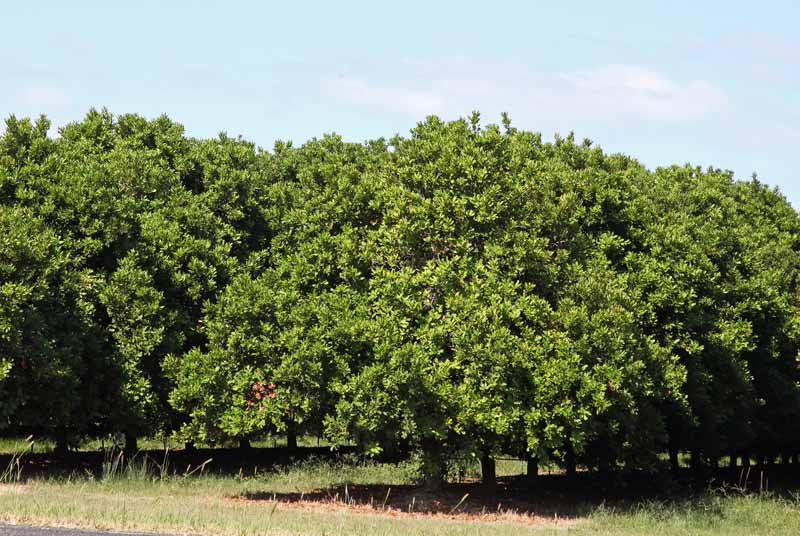
The fruit of this regal tree is a nut with a shell so hard it takes a hammer, a vise, or a specialty tool to crack it. But don’t let this deter you; it’s well worth the trouble to have your own supply of the world’s most expensive nut.
What makes them so pricey?
It’s the resources and labor involved in cultivation, which lowers supply. The macadamia requires a great deal of water, especially when young. If it doesn’t rain, a deep weekly watering is required. In addition, it can not tolerate frost or high wind, and requires protection from both.
And finally, nuts ripen at different times, requiring multiple harvests. Some “self-harvest,” falling to the ground to be scooped up. Other types must be judged ready and picked.
Their hard shells must be cracked open with great force, but without damage to the kernels inside, before being sent off for sorting, processing, packaging, and transport to market. All of this adds up!
Historical Background
Records of the Macadamia genus date to the rainforests of Australia in the 1800s. It was recognized by botanist Ferdinand von Mueller, who named the genus after a close colleague, and began to collect species belonging to it.
Later that century, the macadamia made its way to Hawaii, where it would become a commercial crop.
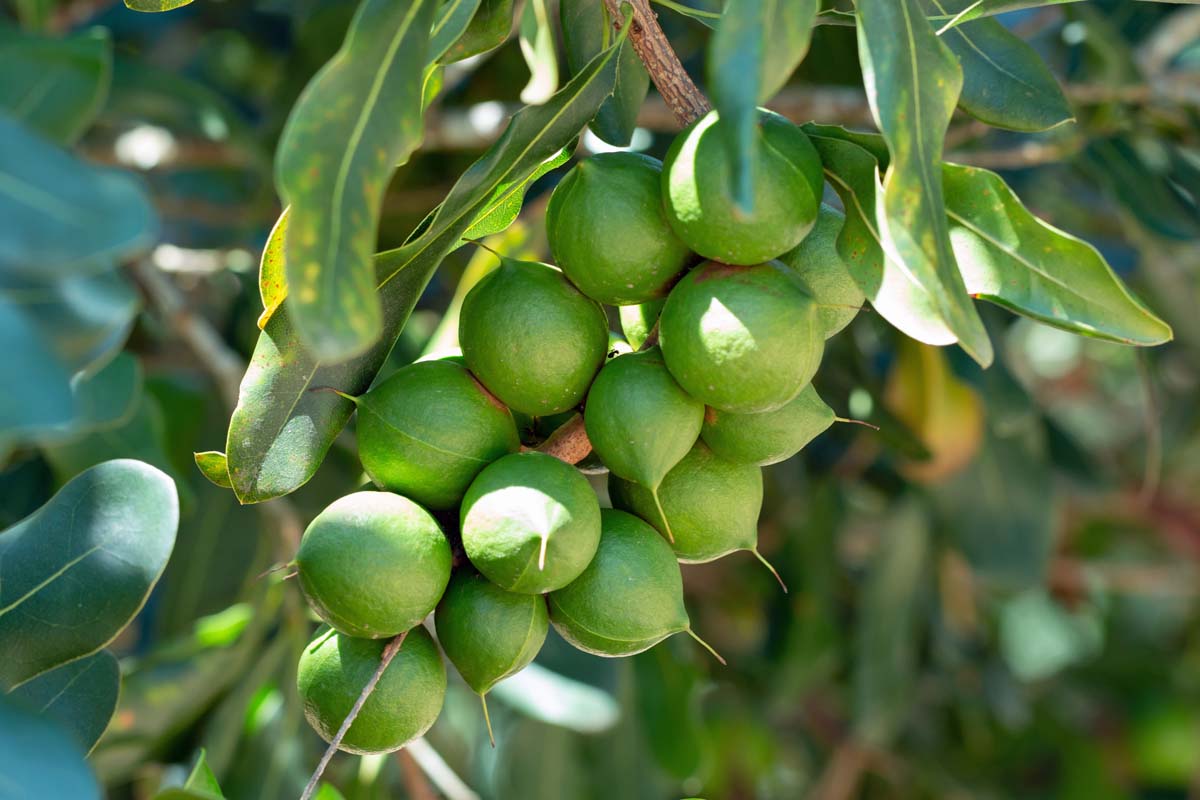
Over the years, numerous plants were added to the Macadamia genus, and often they were lumped under the umbrella of M. internifolia. Even my old version of Rodale’s Ultimate Encyclopedia of Organic Gardening assigns this Latin name to the macadamia tree.
However, by 1965, the genus contained 10 species. In his article, “The Ternifolia Group of Macadamia Species,” in the journal Pacific Science, UC Riverside plant physiologist W. B. Storey built upon Mueller’s work, fine-tuning the genus and classifying just three species in the “Ternifolia group.”
Today, as the result of further advances in classification, there are just four species in the Macadamia genus:
- M. jansenii, the Bulberin nut, an endangered species with bitter nuts.
- M. ternifolia, the Gympi nut, an endangered species with bitter nuts.
- M. integrifolia, the Queensland nut, a commercially-grown crop with a smooth shell and sweet nuts.
- M. tetraphylla, the rough-shelled macadamia, a commercially-grown crop that doesn’t always have a rough shell, and has sweet nuts.
M. tetraphylla, the rough-shelled macadamia, a commercially-grown crop that doesn’t always have a rough shell, and has sweet nuts. M. integrifolia has light green new shoots and 11-inch leaves that are arranged in groups of three. M. tetraphylla has pink new shoots and 20-inch leaves that grow in groups of four.
Per the California Rare Fruit Growers San Diego Chapter, M. tetraphylla has greater heat and frost tolerance than M. integrifolia. And unlike M. integrifolia, it contains variable amounts of fat and sugar that make for color and texture variations when roasted.
When you shop, you’ll find both, as well as hybrids of the two.
Note: Botanical species names often include the name of the “author” of the species, such as M. tetraphylla L. Johnson. You may find M. integrifolia listed as M. integrifolia Maiden & Betche, as well as M. internifolia var. M. integrifolia (Maiden & Betche).
Now let’s learn to grow a macadamia tree at home!
A Note of Caution
Per the Merck Veterinary Manual, the macadamia nut contains a level of toxicity that sickens dogs.
Macadamia Propagation: Tree-Starter Options
The macadamia does not produce true to seed, which means that while you may plant a ripe kernel, it won’t produce a plant that’s exactly like the parent.
This is why commercial producers and nurseries who supply the public rely on cloning techniques to reproduce quality traits.
Here is a brief introduction to various propagation methods:
Air Layered Cloning
Air layering involves wrapping stripped bark in a growing medium until roots form, and then separating the new growth to plant on its own.
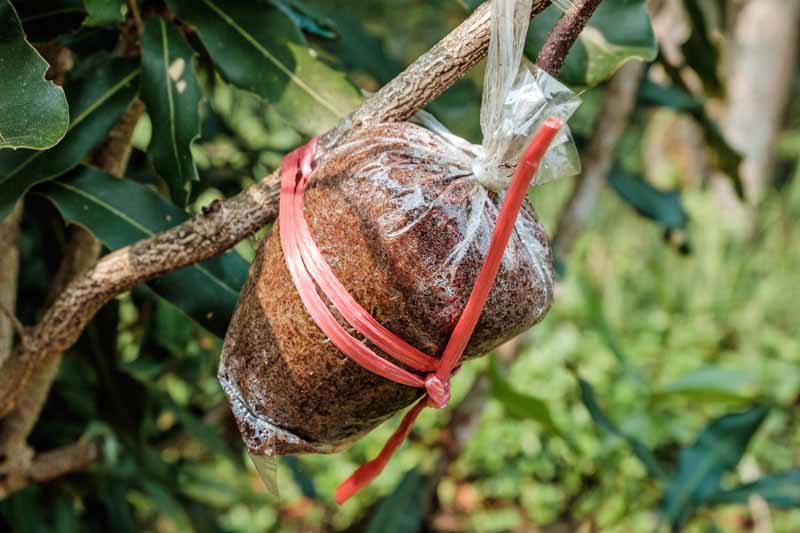
An air layered plant replicates the desirable traits and disease resistance of a parent plant.
The labor-intensive process that this type of cloning involves commands top dollar, but gives you a jump start on the growing process.
Bud Grafting
Budding is a technique in which a “scion” with desirable traits, in this case a bud, is placed into a slit in the branch of a host tree.
Here it establishes a root system, and at the appropriate time, the “nurse” branch is removed and the new plant flourishes on its own.
This is a labor-intensive horticultural process that comes with a considerable price, for a good head start.
Grafting a Cutting
Grafting is the process of inserting scions, in this case cuttings, with desirable characteristics into sturdy rootstock.
A grafted plant offers the combination of a scion with predictable, sought-after characteristics above ground, and sturdy, disease-resistant rootstock below. Usually a “heritage” tree is used, like the ‘Hinde H2.’
It takes several years of excellent nursery care to be able to present an established, grafted plant for sale, so it’s also an expensive option that puts you ahead of the game.
Rooting a Cutting
Another way to start a tree is with a cutting from a young branch. Placing it in a potting medium enriched with a rooting hormone will encourage the wood to slowly grow roots.

Alternatively, you may use the cutting as a scion and graft it to sturdy rootstock.
Nurturing a Seedling
If you purchase a seedling, it will most likely be about six inches tall and have at least one set of true leaves.
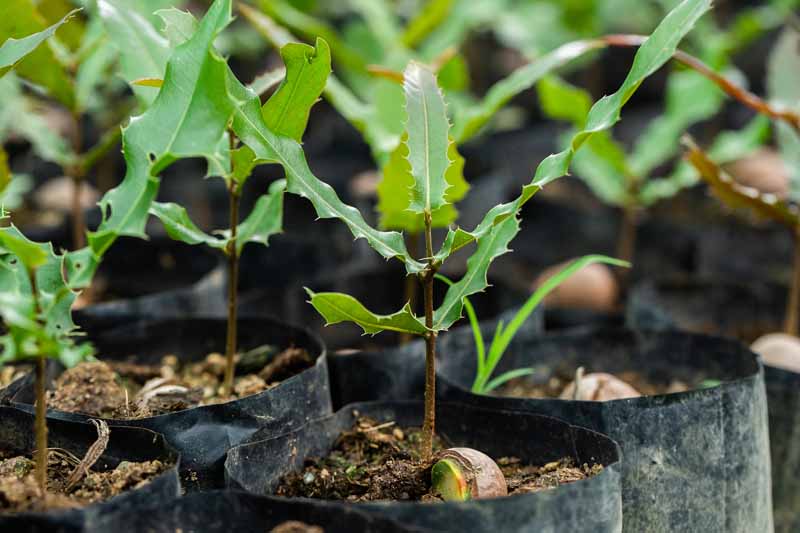
Keep in mind that seedlings like this have been started from seed, and as we’ve said, results are unpredictable.
Sowing a Seed
You’ll find seed on the market, but again, results are questionable. You may also know where there’s a macadamia tree ripe for harvest in your area.
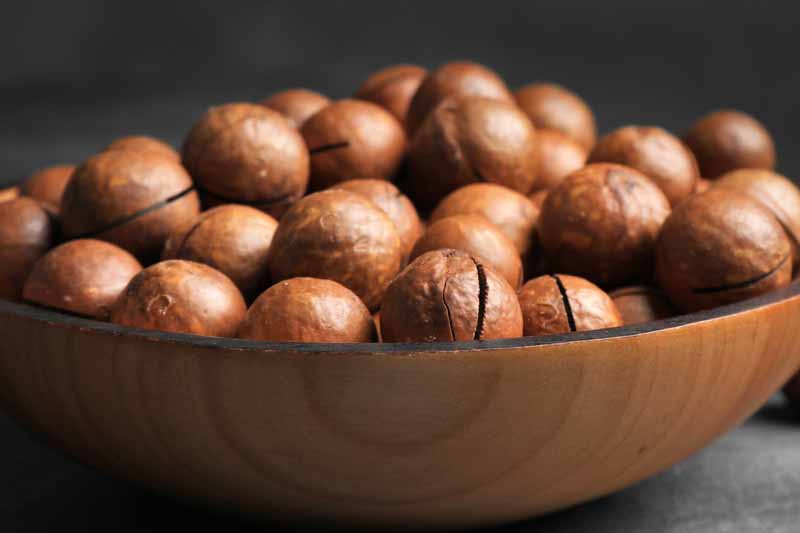
Here’s how to start from seed:
8 Steps to Sprout a Macadamia Seed
- If you have a freshly harvested nut, remove the outer husk to reveal the smooth, brown shell. The seed is inside. It’s the part we usually eat. Plant it right away, or place the nut in a container with some potting medium and sand, and store it in a cool, dry place for the winter.
- When spring arrives, remove the nut from its winter home and place it in water for two days to encourage sprouting.
- Prepare a well-draining pot at least a foot deep with a moisture-retaining potting medium.
- Make a hole in the potting medium that’s twice as deep as the kernel is thick.
- Note the raised ridge on the kernel. Place the kernel in the hole with the ridge parallel to the soil surface, or sideways. Cover loosely with soil.
- Water well and maintain even moisture by watering deeply once a week. This means watering until it begins to run out the bottom of your container, waiting a few minutes, then watering again until it runs out.
- Place your potted seed on a seed-warming tray, or in a sunny window.
- Be patient, as it may take a number of months to achieve a viable seedling.
Planting for Success
With the information outlined above, you’re ready to shop online or at your local plant nursery.
If your goal is to produce substantial crop yields, I recommend starting with grafted plants with known characteristics and a proven track record.
Now, let’s find out what to do with a fledgling macadamia.
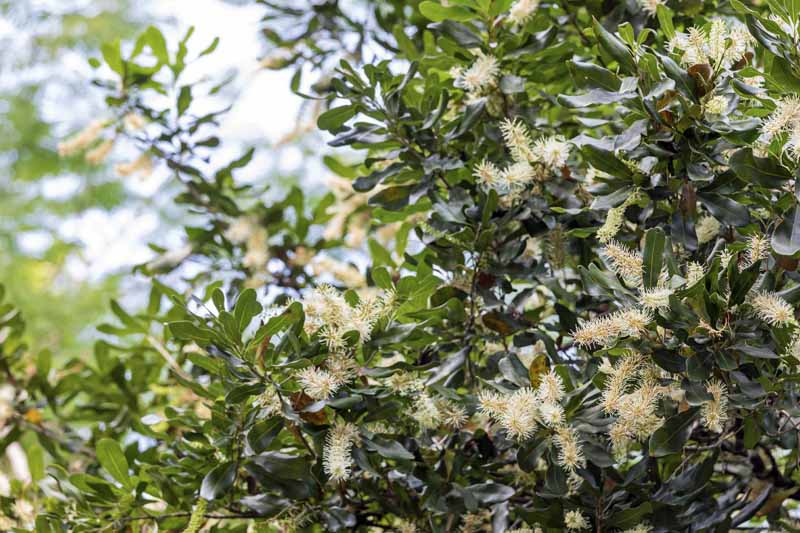
Like the avocado, macadamia grows well in Hawaii, Florida, California, and the southernmost regions of Texas, where the soil is deeply fertile, well-draining, and slightly acidic; the rainfall is abundant; and there’s little danger of frost.
Choose a location with full sun to partial shade that is not vulnerable to high winds, as the branches of this tree are somewhat brittle. Plan for a mature height of up to 50 feet, and a branch spread of up to 40 feet.
Soil Testing
Macadamia has a “proteoid” root system comprised of compact root clusters that take up nutrients with great efficiency.
You would be wise to have your soil tested by your local extension service to determine its acidity and nutrient content. Amend the soil as needed, to achieve a pH of roughly 5.5 to 6.5.
Remediation of the three essential macro-nutrients, NPK, may be recommended.
Nitrogen (N) is difficult to measure, as it is changeable, and will be addressed in the growing section below. Phosphorous (P) is a non-essential for this tree, as it grows in phosphorus-deficient soil in Australia and Hawaii. So, the only macro-nutrient you may need to address is potassium (K).
There may also be micronutrient (copper, iron, manganese, molybdenum, zinc, nickel, and chloride) deficiencies to address. These may be managed with foliar sprays during the growing season.
Planting Seed, Seedlings, Cuttings, and Nursery Stock
The time to start thinking about planting that seed you’ve overwintered, or a nursery seedling, cutting, or rootstock, is in January. By the onset of spring, you should have your macadamia in the ground.
If you’re growing a tree from seed, nurture it until you have true leaves and a stem that’s roughly six inches tall.
Be sure to provide adequate drainage, as pooled water may cause oversaturation, resulting in “damping off,” a condition in which the stem rots and the plant collapses and dies.
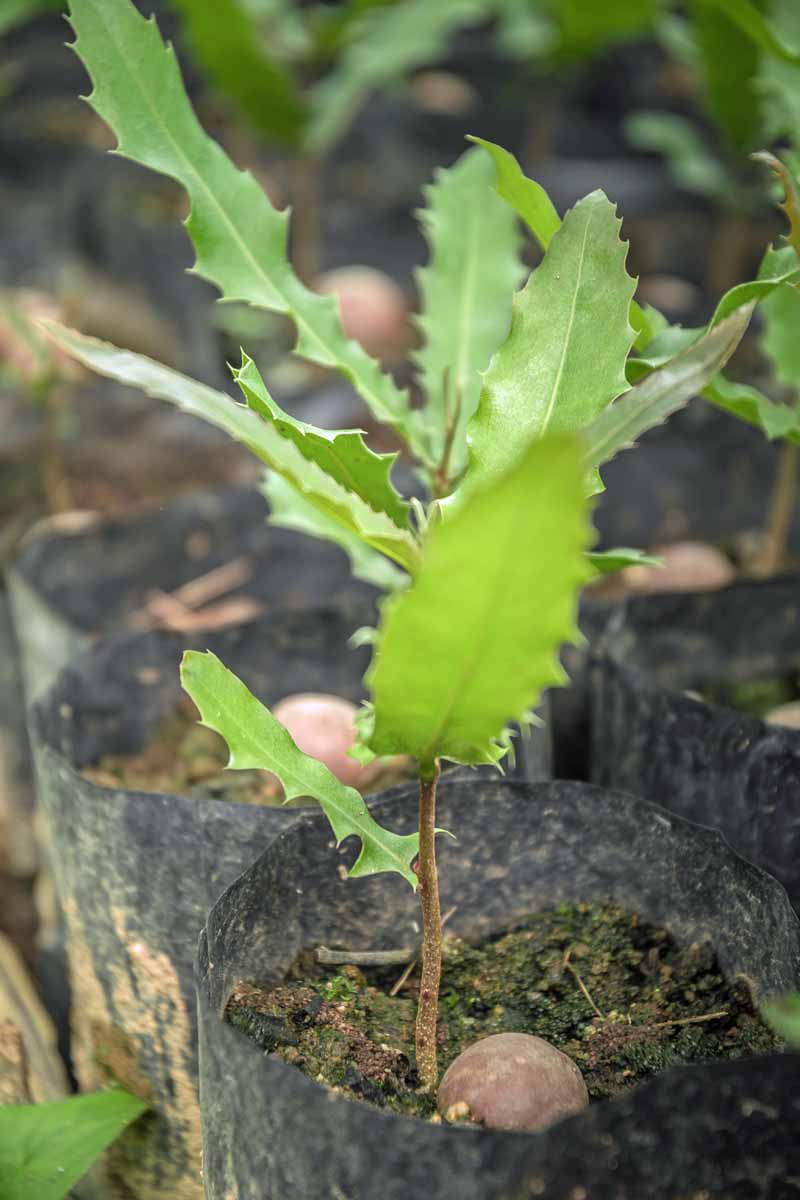
Transplant your homegrown or store-bought seedling to the yard, placing it into deeply worked soil. Be sure to maintain the same planting depth as the seedling experienced in the pot, for a smooth transition.
Alternatively, if you master the art of grafting, you may implant your seedling into quality rootstock.
If you are starting with a cutting purchased or received from a friend, you’ll want to encourage it to form strong roots. Dip it into a rooting hormone and plant it in a deep container of potting medium. When substantial growth is evident, transfer your successfully rooted cutting to the yard.
And if you are planting nursery stock that is well underway, get it into the ground as soon as possible after purchase. Place bare rootstock in a bucket of water until you’re ready for it.
Work the soil to a friable consistency, digging down at least twice as deep as the nursery container, and across twice as wide, to provide ample room for macadamia’s extensive root system.
Unpot your plant and work it into the soil. Keep the pot soil level even with the ground level. For bare rootstock, set the root crown just below the ground soil surface.
Settle your plant in, working dirt around it for support, and tamping down firmly to fill air holes. Make a collar of dirt about two feet out to help with moisture retention.
If you choose to plant several trees, consider their mature dimensions, and add a minimum of 25 additional feet between each, to allow for adequate air circulation and root expansion.
Watering Requirements
The most crucial requirement for macadamia, especially in the sapling stage, is abundant water that drains well.
Per the Macadamia Nut Grower’s Handbook published by the Queensland Government, a mature tree can use up to 350 liters, or about 92 gallons, of water per week in hot, dry weather.
Water freshly sown plants deeply, tamping down the soil a second time to remove any remaining air pockets, and maintain evenly moist soil until your plant begins to grow. Then, in the absence of a drenching rain, water weekly year-round.
Fertilizing
It is not necessary to fertilize macadamia at the time of planting. The California Rare Fruit Growers say you should wait about six months after planting outdoors, then apply a balanced fertilizer that contains 1 percent nitrogen or less, as is appropriate for a slow-growing plant.
A fish emulsion or citrus mix is best, applied per package instructions, usually in fall and winter.
Other folks recommend avoiding phosphorous (P), a nutrient that is deficient in macadamia’s native Australia.
As your tree matures, you may conduct additional testing of your soil and the leaves of your tree to determine if you have an appropriate nutrient balance.
Depending upon the cultivar and how far along your plant is when you get it, your tree should start bearing fruit at about age 6 or 7.
Macadamia Tree Care Tips
Congratulations! You have just planted your first macadamia. Now, here are some insider care tips:
- Protect a young tree from damaging wind and/or frost by draping it with plastic sheeting when weather reports warrant it. Use stakes to aid with stability while tender roots take hold. Wind protection is essential while nuts are forming, or they may drop prematurely.
- Limit companion planting to shallow-rooted cover crops, as deep-rooted plants will disturb the tree’s fragile roots and compete for essential nutrients. A plant like clover aids in moisture retention and aeration, while adding essential nitrogen to the soil.
- Keep the area beneath your tree free of debris, as it may invite insects and rodents seeking shelter. Pull weeds to reduce competition for water.
- While planting deep-rooted plants too close to your tree is ill-advised due to its fragile and extensive root system, filling your nearby gardens with flowers that attract pollinators will increase your chances of achieving a flavorful and abundant fruit harvest.
- A mature tree may withstand drought conditions temporarily, but a severe lack of water will take a toll on harvest quality and quantity.
- In the fall, after harvest time, apply a layer of coconut coir mulch to aid in moisture retention and keep weeds at bay. Be sure to keep it at least a foot away from the trunk.
- When you fertilize in fall and winter, be sure to apply it in a circle beneath the tree’s “drip line.” This is the perimeter below the outermost leaves. With this technique, you’ll avoid burning the bark on the trunk. This is especially important to protect the stems of saplings.
- As your tree matures, prune it in late winter, just before spring. This allows sunlight to penetrate, and encourages a growth habit characterized by one central stem with protruding horizontal branches. Prune trees that don’t self-harvest (drop fruit), and those planted in containers, to a manageable height.
Macadamia Cultivars to Choose
The species of the Macadamia genus have changed little over the past 200 years or so, since von Mueller identified the first.
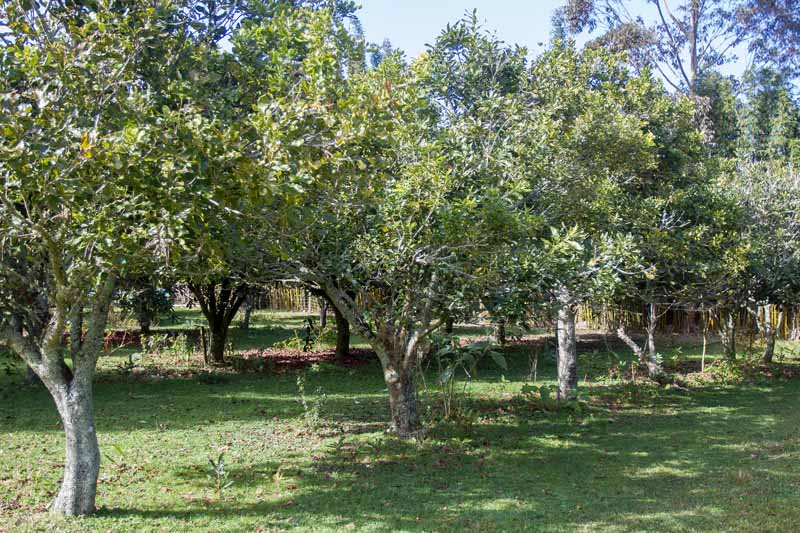
Today’s clones replicate their best qualities, plus improved features such as increased disease resistance and narrower growth habits.
With pruning, some are quite suitable for deep pots.
You can find a standard macadamia nut tree in a one-gallon pot available at Home Depot.
Here are the highlights of seven cultivars you’re likely to find on the market:
Beaumont
‘Beaumont’ is a hybrid from Australia, a cross between M. tetraphylla and M. integrifolia. It has a growth habit that’s more upright than spreading.
The blossoms are an especially showy pink and the nuts are medium to large in size.
The fruiting season is long, but it is not uncommon for some nuts to crack and spoil before falling. This cultivar is highly recommended for the home garden.
Cate
M. tetraphylla ‘Cate’ originated in California. This rough-shelled cultivar is an aggressive grower with a thin shell and more frost hardiness than some.
The fruiting season is short, with medium to large nuts. This is a self-harvesting variety.
Dorado
M. integrifolia ‘Dorado’ originated in Hawaii and has an upright growth habit and medium height.
It’s known for producing an abundance of nuts in as few as five years, as well as its resistance to cold weather.
James
M. integrifolia ‘James’ originated in California and is known for being “precocious,” or a vigorous grower that produces in as few as three years.
It’s a tall species with a column profile that produces self-harvesting medium-sized nuts.
Keaau
M. integrifolia ‘Keaau’ originated in Hawaii. It produces a generous quantity of medium-sized nuts with shells that are somewhat thinner than others.
This is a fairly vigorous tree with an upright growth habit.
Vista
‘Vista’ is a hybrid that originated in California. It grows to medium size in a pyramid shape.
Pink blossoms precede an ample supply of small to medium nuts with shells thin enough to crack with a standard nutcracker. Enjoy self-harvesting in about three years.
Waimanalo
M. integrifolia ‘Waimanalo’ originated in Hawaii, and produces clusters of thick-shelled nuts so large, they sometimes halve to form twins.
Trees are more resistant to frost and disease than some, and are medium-sized with a pyramid shape. This is an excellent producer that bears fruit in about five years.
Managing Pests and Disease
In the continental United States, M. integrifolia and M. tetraphylla are not prone to pests and diseases.
Some pests, like the dreaded macadamia nut borer or Botrytis blossom blight, live in the tree’s native Australia, and are not a problem here in the US. However, a tree may become vulnerable, especially in the event of weather extremes, or over- or under-watering.
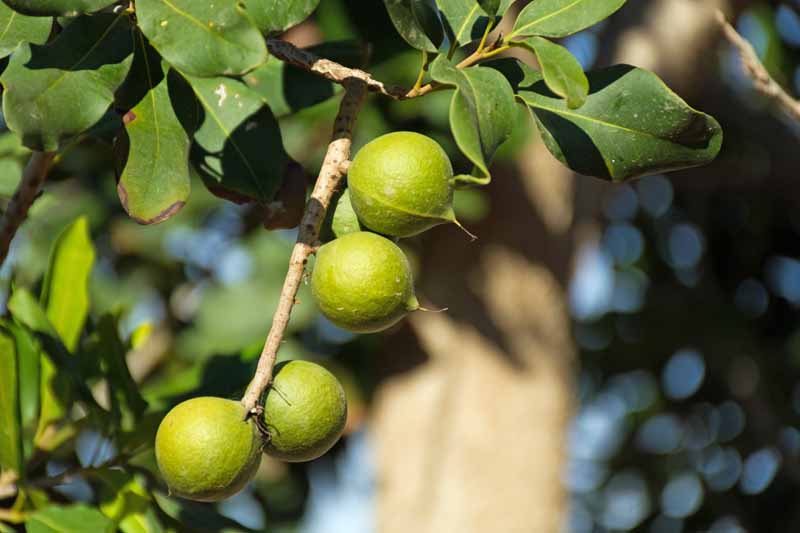
Signs of trouble include discolored, disfigured, or dropping leaves; scarred bark; and prematurely dropping fruit.
And while some pests may make your tree their home, the damage they cause may not be extensive enough to cause large-scale damage to your tree or crop.
The following are some of the pests and diseases you may encounter while cultivating M. integrifolia:
Bacteria and Fungus
When a tree suffers an injury, like a cut from a weed wacker, it may develop a “canker,” or a wound that is vulnerable to bacterial and fungal colonization.
One such fungus is Phytophthora ramorum, which causes cankers to bleed sap and foliage to die.
Another fungus is Anthracnose, or Colletotrichum gloeosporioides, which causes dark lesions on leaves and husks that may (or may not) affect the kernels inside.
Botrytis cinereal, aka blossom or raceme blight, causes flowering stems, or racemes, to become moldy and die.
Deer and Rodents
This is not a deer-resistant plant, so be sure to protect tender young shoots from their voracious nibbling.
In addition, fallen fruit attracts rodents that won’t hesitate to feast upon them if they’re not promptly gathered.
Sap-Sucking Insects
Various types of mites that are present in the garden may feed on the soft leaf and stem tissue of trees weakened by lack of water or disease.
Scale is not a condition, but rather, an insect that damages branch material by literally sucking the life out of it.
Thrips feed on leaves, transmitting disease from plant to plant.
Sharpshooter insects carry Xylella fastidiosa bacteria and damage a plant’s ability to take up water, leading to conditions such as chlorosis and leaf scorch.
And several types of stinkbug have made their way to the United States from elsewhere, feeding on plant tissue and developing kernels.
Contact your local extension service if you suspect pests or disease. They can evaluate your foliage and make appropriate recommendations.
Macadamia Nut Harvesting
Your first harvest is certain to be an exciting event!
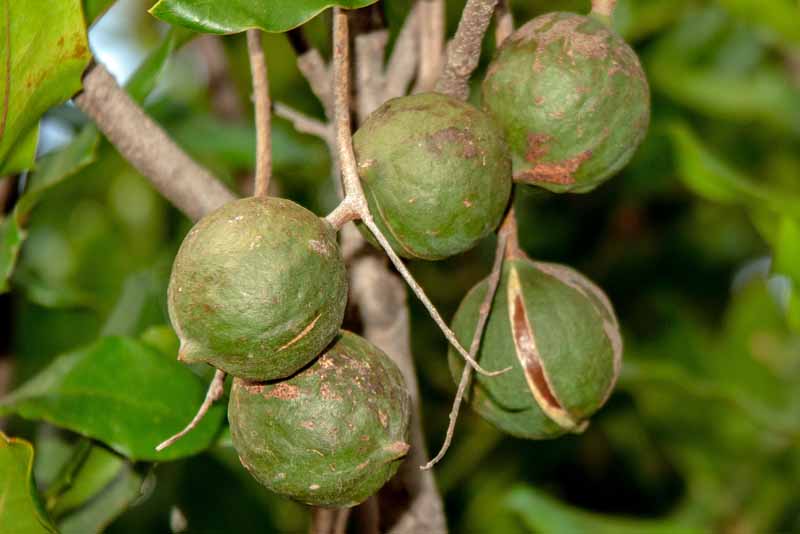
All blossoms don’t produce nuts, but those that do set hefty green husks of about one inch in diameter that turn brown and begin to crack open when ripe.
Inside is a brown nut shell containing an edible kernel. Depending upon the variety or varieties you choose, they will ripen at any time from late fall through spring.
It may be tempting to shake your tree’s branches to make ripe fruit fall, but don’t, because you may also shake down unripe ones, and damage fragile branches.
Some folks place tarps beneath their trees to catch falling fruit, however, this may not be wise for two reasons: it impedes water penetration to the roots, and it retains rainwater that may rot ripe nuts that have fallen.
Macadamia is a unique nut that ripens continuously during the fruiting season, requiring multiple harvests.
As mentioned earlier, some varieties self-harvest, falling to the ground for easy retrieval.
Others must be gathered by hand off the branches; although they do drop to the ground, they don’t all drop at the same time as do those of cultivars in the self-harvesting group.
Get detailed instructions on harvesting here.
Preserving Macadamia Nuts
Post-harvest, proper preservation and storage are essential to protect your crop from spoiling before you’re ready to use it.
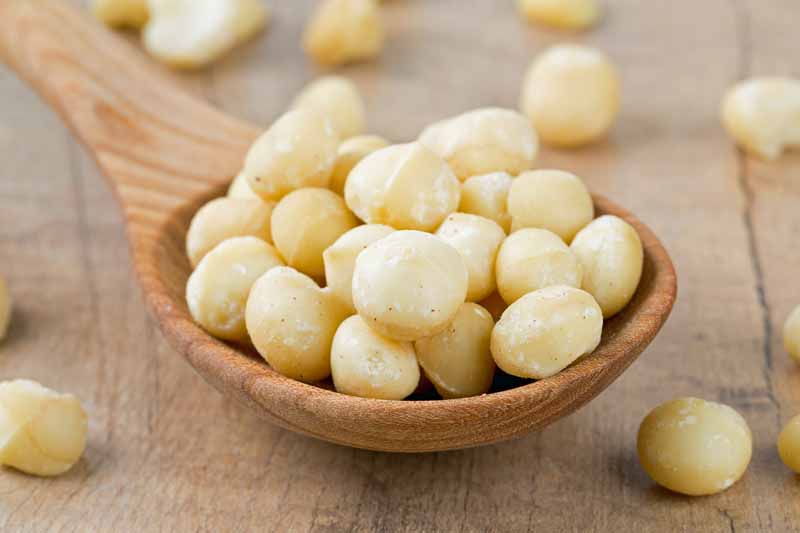
The University of Hawaii’s College of Tropical Agriculture and Human Resources recommends the following:
6 Steps to Dry and Roast Macadamia Nuts
- Remove the outer husks and place nuts on a screen no more than two deep.
- Air dry for two to three weeks in a cool, dry location, to loosen kernels from their shells.
- Use a vise or specialty nutcracker to crack the nutshells and remove the kernels.
- Dry the kernels in a food dehydrator or the oven at a temperature of 100°F, increasing to 140°F after about two days. For best results, don’t rush this process. Kernels are sufficiently dry when crisp to the bite.
- At this point, you may roast the kernels, store them in airtight jars, or freeze them for future use.
- Roast kernels on a wire rack in a single layer in a 275°F oven until golden. Be sure to keep a close eye on them, so they don’t burn.
The Encyclopedia of Country Living advises that nuts in shells that are protected from heat and light will keep for one year. Shelled nuts in tightly closed containers keep for several months in the fridge. And you may freeze shelled or unshelled kernels for up to two years.
Macadamia Quick Reference Growing Chart
| Plant Type: | Nut tree | Tolerance: | Mature trees moderately drought tolerant; new cultivars moderately tolerant of frost |
| Native to: | Australia | Maintenance: | Low |
| Hardiness (USDA Zone): | 9-11 (subtropical-tropical) | Soil Type: | Prefers loamy and fertile |
| Season: | Year round | Soil pH: | Slightly acidic, 5.5-6.5 |
| Exposure: | Full sun to part shade | Soil Drainage: | Well-draining |
| Time to Maturity: | 12 to 15 years | Companion Planting: | Cover crops like clover to aerate, facilitate water penetration, and add nitrogen over plant roots; flowering plants outside root zone to attract pollinators |
| Spacing: | 25 feet minimum | Attracts: | Bees and other pollinators while flowering; various herbivores and omnivores after nut fall |
| Planting Depth: | Same depth as nursery pot, set bare root crown just below the soil surface | Order: | Proteales |
| Height: | 30-40 feet | Family: | Proteaceae |
| Spread: | Up to 33 feet | Subfamily: | Grevilleoideae |
| Water Needs: | Moderate to high | Genus: | Macadamia |
| Common Pests: | Some varieties of bacteria and fungi, deer, rodents, and sap-sucking insects may pose a threat to stressed and vulnerable trees | Species: | M. integrifolia, M. tetraphyll |
Recipe Suggestions
Per the NCBI US National Library of Medicine National Institutes of Health, while the macadamia contains a whopping 76 percent fat, its fatty acid composition is beneficial.
This is because the saturated portion is low, and the monounsaturated is high, making it a “MUFA-rich” food (Mono-Unsaturated-Fatty-Acid).
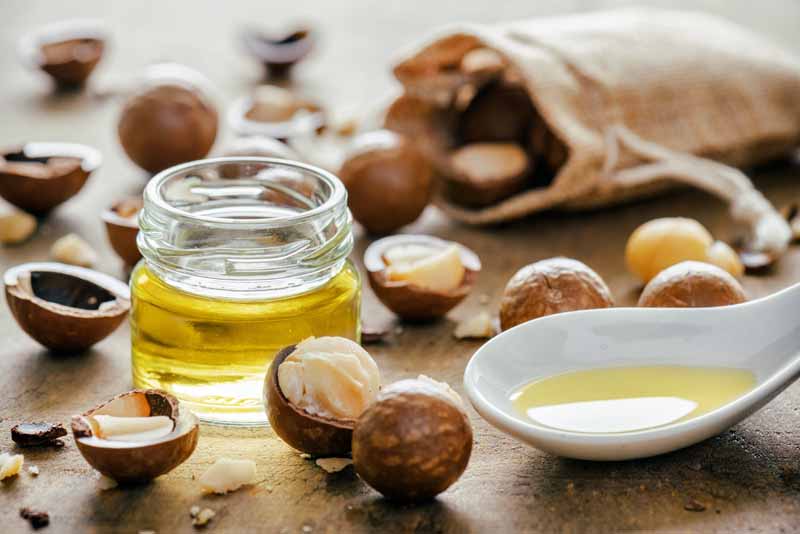
It’s also an excellent source of protein that contains essential amino acids, calcium, dietary fiber, magnesium, and potassium.
Consumption may contribute benefits to cardiovascular and nervous system health.
Macadamias are delicious raw or roasted, and they’re heavenly in chocolate chip cookies! Don’t hesitate to substitute this delectable nut for walnuts in recipes like Whole Wheat Bread Pudding and Sugar and Spice Candied Nuts, found on our sister site, Foodal.
If you’re feeling adventurous, you may even try your hand at cold-pressing, to extract flavorful oil for use in cooking, fresh dressings, and hand-crafted body lotions.
And macadamia nut milk makes a delicious dairy-free treat to add to your coffee.
Macadamia Nut Crusted Halibut with Fresh Herbs and Coconut Sauce
Are you looking for an easy but elegant seafood dish to prepare for a dinner party?
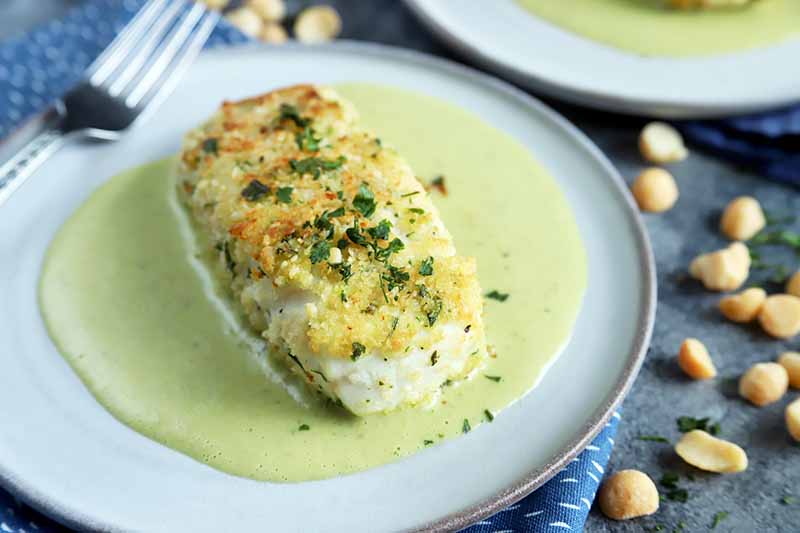
This macadamia nut crusted halibut will fit the bill! Flaky and moist fish with a crispy exterior, and drizzled in a smooth herbed coconut sauce, this dish will transport you to a warm and breezy Pacific island.
Soft and Chewy White Chocolate Macadamia Nut Blondies
These white chocolate macadamia nut blondies are super easy to make and require minimal prep work.
The classic cookie is transformed into a chewy, soft, and luxurious treat that your friends and family will think you’ve spent ages preparing.
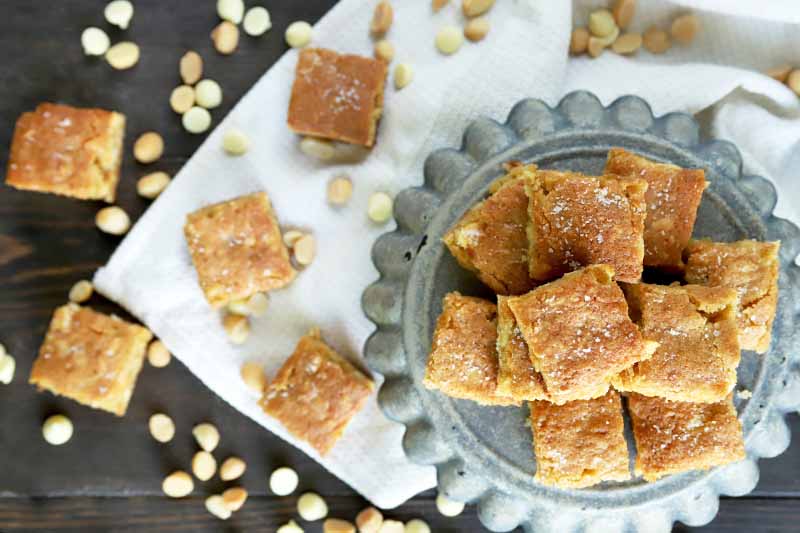
This one will soon become your go-to dessert for potlucks, gatherings, and anytime you feel like indulging.
Form, Function, and Fabulous
If you can’t resist the flavor of the exotic macadamia, it’s definitely time to grow your own.
Imagine its branches casting glorious shade, blossoming in spring, and providing you with sweet, creamy nuts for mouth-watering desserts. And what will your friends say, when you share your gourmet stash with them?!

Adding a tree to your outdoor living space is not only a beautiful choice, but one that provides habitat for wildlife, like the songbirds and beneficial insects that call your yard home. And when that tree also puts food on the table, it just doesn’t get any better.
Happy gardening!
If you found this guide valuable, here are some more informative articles you may enjoy:
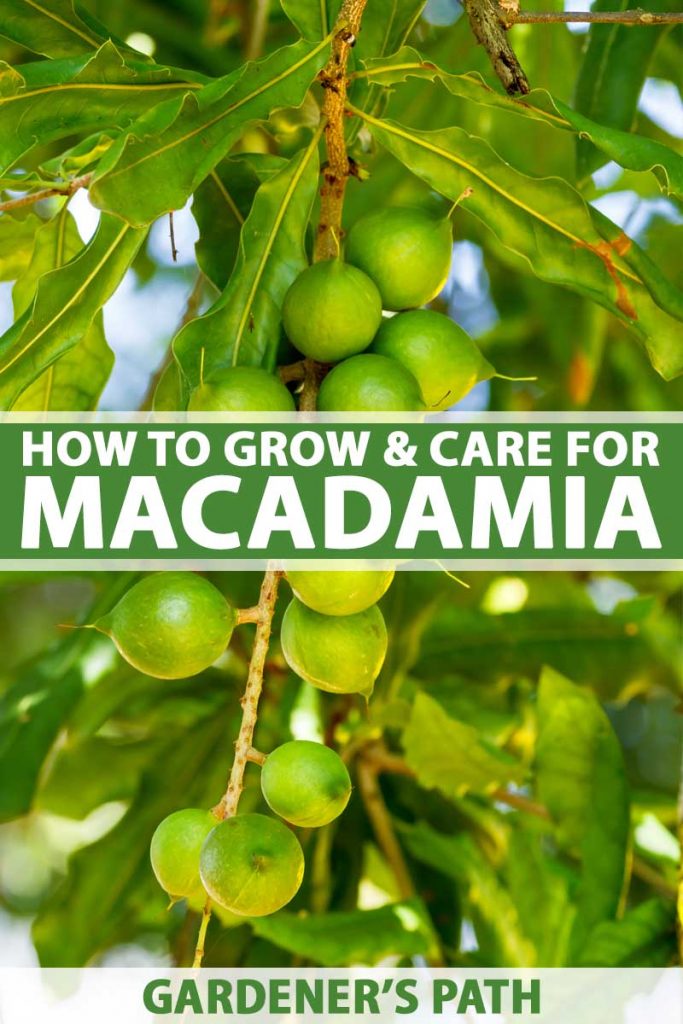
Your quote. “Other folks recommend avoiding phosphorous (K), a nutrient that is deficient in macadamia’s native Australia.”
K is potassium (from the Medieval Latin ‘kalium’ or ‘kali‘, from which we get the word alkali.)
P is phosphorus which is deficient in Australian soils and of which the proteacea are not fond. Adding P to the soil may be not the best idea.
Thank you so much for catching my error. Phosphorus is indeed P, not K. This correction will be made asap.
I wish I had known this tree 50 years ago. We were so busy with Plant Research and we did not concentrate on growing a specific species. Now we are preparing a nursery just for Macadamias. Our research has led us to assist trees in growing roots 6 times bigger and deeper. Great article.
As promised, we just germinated our first seeds and we did Air Layering. Just waiting for spring to harvest the branches and grow our Macadamias. Our systems are working well. We started germination in the midst of Winter.
Hi, Nan. Very nice article. How much summer heat do the trees need? Would any cultivars do well in the cool summers (low-to-mid 70’s) and near-zero frost areas of the San Francisco Bay Area? And can any of those cultivars be kept to around 10′ tall? Thanks.
Thank you, Shawn. Temperatures in the upper 70s are ideal, so your summers may be well-tolerated. Temperatures that briefly dip as low as the 20s in winter may also be tolerated, but for near-zero, you will have to insulate. There are dwarf trees, but you can always prune a full-size tree just after harvest each year to keep it small. My best advice is to speak with a local nursery representative who may have experience with growing macadamia trees in your area.
How I’m going to grafted macadamia tree and can I plant using seeds
Hello Mukwevho –
A grafted macadamia tree is made by inserting a cutting into sturdy rootstock. You can also take a cutting and root it in potting medium with rooting hormone. And yes, you can also start a tree from seed, provided it is fresh and viable.
Hi Nan, I’ve just stumbled across this article a bit belatedly – I hope you’re still checking in for responses. For about a year now, I’ve been planning to purchase a Mac Nut tree for my subtropical garden here on the North- Central CA Coast. In researching my choices, I keep running across favorable mention of the variety ‘Waimanalo’ – in this article, in articles about growing Mac Nuts in (cooler) North and Central Florida – even on the CA Rare Fruit Growers (CRFG) website. Trouble is – I can’t seem to find a nurseryman who’s heard of it! Not… Read more »
Hello Chris –
As M. integrifolia ‘Waimanolo’ does not seem to be available, I suggest that you discuss a rough-shelled variety, M. tetraphylla ‘Cate’, with a local nursery representative. This is a cultivar that originated in Malibu, CA, and is widely grown commercially. If it is also unavailable in your area, ask the rep to suggest a variety that would be a suitable.
Hi Nan – Thanks for your reply. I’m well acquainted with ‘Cate’ as a readily available option . Apart from Beaumont, it’s virtually every subtropical nursery’s default cultivar – here in California at least. What I was really trying to get at is the fact that this article and many others seem to be providing the CA Rare Fruit Growers list of recommended cultivars – which gives prominent, favorable mention to Waimanalo – by default. But nobody I’ve spoken with seems to have any personal basis for including Waimanalo in their preferences. I have no particular axe to grind against… Read more »
Fair points, Chris, and thank you for your feedback!
We’ll do our best to take a closer look at the Waimanalo variety, and other cultivars. Overall, there simply aren’t that many macadamia nut cultivars available, but I’d love to know myself if there are any currently in development. If this is the case, they often take years to come onto the market, longer if they are developed outside the US. Though I did at one point have a macadamia-growing contact in southern California, that was some years ago. Will try to get back to you as soon as we can.
Our favorable mention of ‘Waimanalo’ is in part a matter of supply and demand- there simply isn’t a huge variety of cultivars available currently to home gardeners. I’d encourage you and any of our readers, if you are in a macadamia growing area, to consult with local nurseries and plant experts to see what you are able to find! While the Hawaii Agricultural Experiment Station was known prominently for their development of macadamia cultivars dating back to 1934, the best expert resource from them that I was able to track down for you today dates back to 1984, and notes… Read more »
VERY MUCH USEFUL GUIDE OFFERING MORE INFORMATION. I NEED THIS BOOK
Is there any variety of macadamia nuts to be planted here in Belize in Central America? Our baldy hills are at an altitude of 700 to 900 meters, temperature 60 to 90F. Good advice will be appreciated.
Hello Leonard –
While Hawaiian cultivars may be appropriate, I recommend that you contact a local nursery, as our resources pertaining to your region are limited.
Hi Nan,my name is Nurdin from Tanzania i have about 50 hacres and i real wanted to go for macadamia nut tree plantation, could you help me on the early process like where do i find the nursery.
Hello Nurdin –
As my resources for your region are limited, I recommend that you get in touch with Farm Africa for guidance.
Great stuff, good read… all the way from Kenya.
Quick one….we’re a medium sized macadamia processing facility in the heart of macs growing region in Central Kenya. We wish to access the US market for bulk mac buyers… would you be kind enough to suggest any leads?
Kind regards
Can’t say that I’m familiar with any offhand, Charles! Perhaps you could try reaching out to some of our recommended sellers directly, or other readers may be able to help.